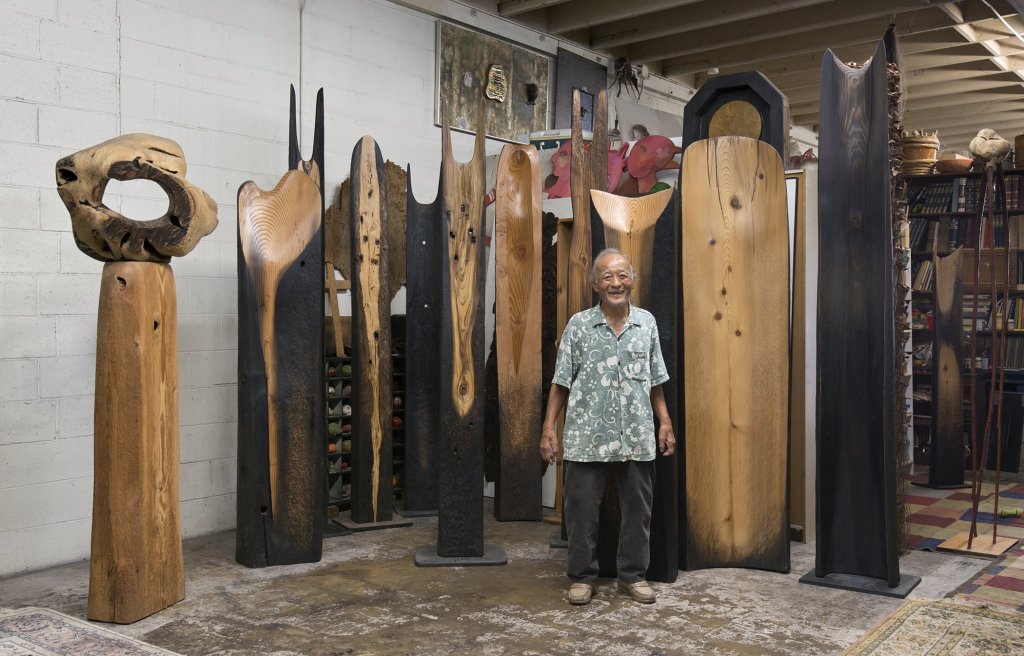ART WORLD NEWS
Kenzi Shiokava, Sculptor of Mystical, Totemic Wood Figures, Has Died at 83
Kenzi Shiokava, the Los Angeles–based sculptor who turned tree trunks into towering, totemic forms, died on June 18 at 83. The Japanese American National Museum in Los Angeles announced the news of the artist’s passing in an Instagram post.
Working quietly for decades from a body-shop-turned-studio in Compton, Shiokava created an immense oeuvre that spanned curiosity boxes, junk assemblage, and wood and macramé abstract figures inspired by his Japanese-Brazilian heritage.
Since the mid-1960s, Shiokava mixed and remixed disparate cultural influences that were in stark opposition to much of the art-making in fashion in California at the time, from Light and Space to heady conceptual work. Because of this, institutions had a hard time fitting Shiokava’s wide-ranging work into any one artistic category. Though he had prominent supporters of his art, including actors Marlon Brando and Jack Nicholson, Shiokava wasn’t able to support himself through the sale of his art alone; he was the longtime groundskeeper for Brando’s L.A. home.
Related Articles
In 2016, at 78, Shiokava received mainstream recognition for his art, when he was include in that year’s edition of the Hammer Museum’s “Made in L.A.” biennial. The show’s curators, Hamza Walker and Aram Moshayedi, included 66 of his sculptures composed from felled trees and telephone poles. Gathered, they resembled an alien forest or relics of an ancient mystical rite. For his participation in the show, Shiokava won the biennial’s $25,000 Public Recognition Award, which was decided by a public vote.
“I didn’t know it’d be like this,” he told the Los Angeles Times in 2016. “The response has been amazing.”
Shiokava was born and raised in Santa Cruz do Rio Pardo in Brazil, the son of Japanese immigrants who had fled their home country because of economic hardship. In 1964, when he was 25, Shiokava hitched a ride aboard a military transport vehicle to Los Angeles, where his sister had relocated years prior. He considered pursuing a practical degree like medicine but flunked the entrance exam. He viewed the failure with relief: “I felt freer,” he recalled to the L.A. Times.
Instead, he decided to attend art school, and was accepted at the prestigious Chouinard Art Institute on the strength of his sketchbook and slim portfolio of paintings. But he was unhappy studying painting; drawing and silk screening were an equally bad fit. In his fourth year, he was required to take a sculpture class.
“I started cleaning some of the wood and I realize: ‘That’s it! It’s wood!’” he said. “It has a history. It’s right there. I was so excited—nothing else mattered.” He soon created his first series of totemic figures, which were exhibited alongside several assemblages at Chouinard’s gallery.
Joan Ankrum, of Ankrum Gallery, noticed the display and gave Shiokava a solo show in the fall of 1979. His work was generally well-received—a review in the New York Times highlighted his “subtle and provocative undulations”—but it was difficult to sell. He continued with his studies and obtained a master’s in fine arts at Otis Art Institute in 1974.
Shiokava was an artist in residence at the Watts Towers Art Center for several years, and his work was exhibited at the space in a group exhibition in 2012. He was included in the Japanese American National Museum’s exhibition “Transpacific Borderlands: The Art of Japanese Diaspora in Lima, Los Angeles, Mexico City, and São Paulo,” which opened in 2017 as part of the Getty Foundation’s Pacific Standard Time: LA/LA initiative.
Until his death, Shiokava steadily produced increasingly detailed work—towering carved columns and dioramas of knickknacks scavenged from thrift stores and garage sales.
“What’s always kept me going is people coming to my studio and enjoying the work,” he said. “But now I know my work will have a legacy. My work will live.”











